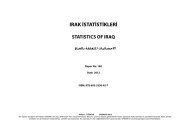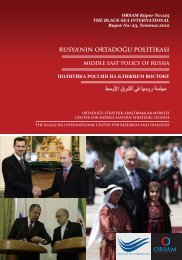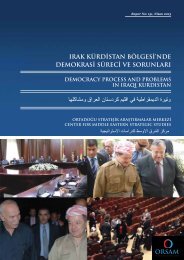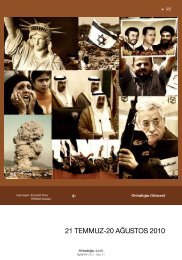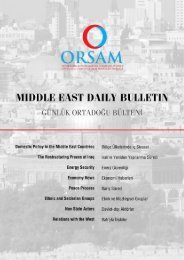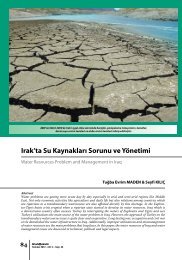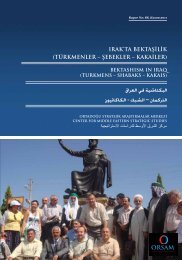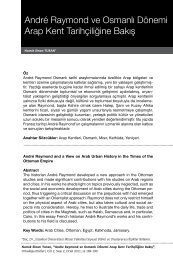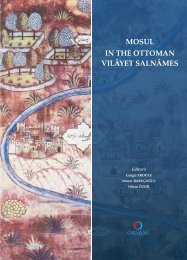GAO-02-359T Gulf War Illnesses: Similarities and ... - orsam
GAO-02-359T Gulf War Illnesses: Similarities and ... - orsam
GAO-02-359T Gulf War Illnesses: Similarities and ... - orsam
You also want an ePaper? Increase the reach of your titles
YUMPU automatically turns print PDFs into web optimized ePapers that Google loves.
<strong>GAO</strong><br />
For Release on Delivery<br />
Expected at 10:00 a.m. EDT<br />
Thursday, January 24, 20<strong>02</strong><br />
United States General Accounting Office<br />
Before the Subcommittee on National<br />
Security, Veterans' Affairs, <strong>and</strong><br />
International Relations, Committee on<br />
Government Reform, House of<br />
Representatives<br />
GULF WAR ILLNESSES<br />
<strong>Similarities</strong> <strong>and</strong><br />
Differences Among<br />
Countries in Chemical <strong>and</strong><br />
Biological Threat<br />
Assessment <strong>and</strong> Veterans'<br />
Health Status<br />
Statement of Nancy Kingsbury, Ph.D., Managing Director,<br />
Applied Research <strong>and</strong> Methods<br />
<strong>GAO</strong>-<strong>02</strong>-<strong>359T</strong>
Mr. Chairman <strong>and</strong> Members of the Subcommittee:<br />
We are pleased to participate in this international hearing by presenting<br />
our findings on differences in illnesses, as well as exposure, among the<br />
Allied Forces—France, the United Kingdom (U.K.), <strong>and</strong> the United States<br />
(U.S.)—that served in the Persian <strong>Gulf</strong> <strong>War</strong>, which began in 1990. My<br />
statement is based on on our report entitled Coalition <strong>War</strong>fare: <strong>Gulf</strong> <strong>War</strong><br />
Allies Differed in Chemical <strong>and</strong> Biological Threats Identified <strong>and</strong> in Use<br />
of Defensive Measures, which we issued on April 24, 2001, <strong>and</strong> subsequent<br />
work that we conducted at your request. 1<br />
As you know, shortly after the war, some veterans began reporting<br />
illnesses that they believed might be due to exposure to chemicals; to<br />
medical countermeasures, such as drugs <strong>and</strong> vaccines, to guard against<br />
chemical <strong>and</strong> biological warfare agents; <strong>and</strong> to other potentially hazardous<br />
substances used during the war. In the United Kingdom (U.K.) <strong>and</strong> the<br />
United States (U.S.), such exposure has been evaluated as a possible cause<br />
of illnesses among veterans. In France, the legislature has recently<br />
completed an inquiry into the health of French veterans of the <strong>Gulf</strong> <strong>War</strong>.<br />
Consequently, the French government has decided to study this issue<br />
systematically.<br />
In our testimony today, we will present our findings on differences among<br />
the French, U.K., <strong>and</strong> U.S. forces concerning the assessment of Iraqi<br />
chemical <strong>and</strong> biological threats <strong>and</strong> the use of various medical<br />
countermeasures. We will also report on the extent of illness, as well as<br />
exposure, reported by each country’s veterans. In particular, we will focus<br />
on the results of population-based surveys of <strong>Gulf</strong> <strong>War</strong> veterans’ exposure<br />
to chemicals, as well as drugs <strong>and</strong> vaccines to guard against warfare<br />
agents. For a discussion of our scope <strong>and</strong> methodology, see appendix I.<br />
For a list of the organizations we contacted in France <strong>and</strong> the United<br />
Kingdom, see appendix II.<br />
Background<br />
Following the Iraqi invasion of Kuwait on August 2, 1990, the United<br />
Nations (U.N.) set a deadline of January 15, 1991, for Iraqi withdrawal<br />
from Kuwait <strong>and</strong> authorized military action to enforce this deadline. These<br />
U.N. resolutions formed the legal canopy for the Persian <strong>Gulf</strong> <strong>War</strong>, which<br />
1<br />
Coalition <strong>War</strong>fare: <strong>Gulf</strong> <strong>War</strong> Allies Differed in Chemical <strong>and</strong> Biological Threats<br />
Identified <strong>and</strong> in Use of Defensive Measures (<strong>GAO</strong>-01-13, April 24, 2001).<br />
Page 1<br />
<strong>GAO</strong>-<strong>02</strong>-<strong>359T</strong>
included the largest international military coalition in combat since World<br />
<strong>War</strong> II. The size of the coalition forces varied greatly, as did location in the<br />
theater: French ground forces were on the western flank; U.S. forces were<br />
spread across the theater; <strong>and</strong> U.K. forces were concentrated closer to the<br />
Saudi-Kuwaiti border. It has been reported that during this deployment,<br />
many troops had known or potential exposure to a variety of substances<br />
with known or suspected health effects, including chemicals (for example,<br />
organophosphate pesticides), drugs (for example, pyridostigmine<br />
bromide), <strong>and</strong> vaccines (for example, the vaccine against anthrax).<br />
Differences in Threat<br />
Assessment<br />
The coalition countries drew different conclusions about the threats posed<br />
by Iraq. As shown in table 1, during the <strong>Gulf</strong> <strong>War</strong>, both the United Kingdom<br />
<strong>and</strong> the United States considered biological warfare a possible threat, but<br />
France did not. Specifically, the United Kingdom <strong>and</strong> the United States<br />
jointly concluded that use of anthrax or botulinum toxin was possible. The<br />
United Kingdom alone concluded that plague was a threat.<br />
Table 1: Differences in Threat Assessment by Country<br />
Country Biological warfare Chemical warfare Nuclear/radiation<br />
France No Yes No<br />
United Kingdom Yes Yes No<br />
United States Yes Yes Limited<br />
Although the coalition countries agreed that chemical warfare was a<br />
threat, they did not agree about the specific types of chemical agents that<br />
might be used. Both the U.K. <strong>and</strong> U.S. assessments found that Iraq had<br />
weapons capable of delivering blister <strong>and</strong> nerve agents. Immediately<br />
before the war, the U.K. found Iraq’s chemical weapon capability to<br />
include nerve agents, blister agents, <strong>and</strong>, probably, a blood agent,<br />
hydrogen cyanide. Similarly, at the time of the war, the U.S. military found<br />
that Iraq had weapons capable of delivering nerve agents — including<br />
sarin, soman, <strong>and</strong> VX — <strong>and</strong> the blister agent, mustard. 2 In November 1990,<br />
the U.K. specifically concluded that the Iraqis had dust impregnated with<br />
2<br />
Final Report, Presidential Advisory Committee on <strong>Gulf</strong> <strong>War</strong> Veterans’ <strong>Illnesses</strong><br />
(Washington, D.C.: Dec. 1996), p. 107.<br />
Page 2<br />
<strong>GAO</strong>-<strong>02</strong>-<strong>359T</strong>
sulfur mustard, commonly known as “dusty mustard.” 3 In contrast to this<br />
U.K. assessment, French officials did not believe agents in dust form were<br />
present before, during, or after the war.<br />
Differences in<br />
Medical<br />
Countermeasures—<br />
Drug <strong>and</strong> Vaccines—<br />
Against Chemical <strong>and</strong><br />
Biological Threats<br />
France, the United Kingdom, <strong>and</strong> the United States adopted varied<br />
combinations of protective drugs <strong>and</strong> vaccines for protection against the<br />
threat of chemical or biological exposure; each country employed these<br />
drugs <strong>and</strong> vaccines to a different extent. Some of the differences could be<br />
attributed to each country’s having identified different threats. For<br />
example, as shown in table 2, France, which did not identify a biological<br />
threat, did not use vaccines to protect against biological threats <strong>and</strong><br />
reportedly relied more on protective gear than did either the U.S. or the<br />
U.K. Similarly, the U.S. did not identify plague as a threat, although the<br />
U.K. did; therefore, the U.S. did not require forces to receive plague<br />
immunization.<br />
Table 2: Differences in Medical Countermeasures Used Against Biological Threats<br />
by Country<br />
Country Anthrax Botulinum toxin Plague<br />
France No No No<br />
United Kingdom Yes No Yes<br />
United States Yes Yes No<br />
In addition, some differences occurred in the use or selection of medical<br />
countermeasures even when the same threat had been identified. For<br />
example, botulinum toxin was identified as a threat by both the United<br />
States <strong>and</strong> the United Kingdom. But the United Kingdom addressed it with<br />
antitoxin to be given post-exposure; the United States addressed it with<br />
investigational botulinum toxoid vaccine, to be administered before<br />
exposure. Similarly, the countries took different approaches to managing<br />
the mismatch between the st<strong>and</strong>ard schedules for immunization <strong>and</strong> the<br />
time available to prepare for war. The U.K. used pertussis vaccine as an<br />
adjuvant for anthrax vaccine, in the belief that this would help soldiers<br />
3<br />
In addition, U.K. analyses of <strong>Gulf</strong> <strong>War</strong> decision making state that it was known that Iraq<br />
had been provided information on the nerve agent soman, the choking agent phosgene, the<br />
psychochemical BZ, <strong>and</strong> the vomiting agent adamsite.<br />
Page 3<br />
<strong>GAO</strong>-<strong>02</strong>-<strong>359T</strong>
achieve adequate immunity by the projected onset of the war. 4 All three<br />
countries employed a drug, pyridostigmine bromide, to enhance the<br />
effectiveness of post-attack therapy for exposure to the nerve agents, such<br />
as soman, but the extent <strong>and</strong> duration of its use differed somewhat across<br />
the coalition countries.<br />
Finally, the use of medical countermeasures for biological <strong>and</strong> chemical<br />
threats varied within, as well as across, national comm<strong>and</strong>s. For example,<br />
based on official report <strong>and</strong> survey data, the U. S. administered botulinum<br />
toxoid vaccine to only a small portion of its forces. Similarly, the U.K.<br />
reported that it administered the first anthrax injection to over 75 percent<br />
of its deployed forces, with some units fully vaccinated.<br />
Differences in Extent<br />
of Illness Reported by<br />
Veterans<br />
To date, French veterans of the <strong>Gulf</strong> <strong>War</strong> have not reported as many<br />
illnesses since the conflict as their counterparts from the U.K. <strong>and</strong> U.S.<br />
Since the war, the U.K. <strong>and</strong> the U.S. veterans have reported illnesses at<br />
rates that are significantly higher than veterans who were not deployed or<br />
deployed elsewhere. 5 Across several studies of U.K. <strong>and</strong> U.S. veterans, the<br />
rates of illnesses reported by those deployed to the <strong>Gulf</strong> <strong>War</strong> have<br />
consistently been between 25 <strong>and</strong> 30 percent greater than the rate<br />
reported by comparison groups of veterans.<br />
In the U.K., researchers surveyed three groups of veterans: U.K. <strong>Gulf</strong> <strong>War</strong><br />
veterans, U.K. veterans deployed to Bosnia, <strong>and</strong> U.K. veterans deployed<br />
elsewhere during the <strong>Gulf</strong> <strong>War</strong>. <strong>Illnesses</strong>—including symptoms <strong>and</strong><br />
disorders—were reported significantly more frequently by the <strong>Gulf</strong> <strong>War</strong><br />
veterans than by the other two groups of veterans. Even after adjusting for<br />
various factors, reporting of illness was significantly higher among <strong>Gulf</strong><br />
<strong>War</strong> veterans than among others. In particular, <strong>Gulf</strong> <strong>War</strong> veterans were<br />
more likely to report substantial fatigue <strong>and</strong> symptoms of post-traumatic<br />
4<br />
An adjuvant is a substance incorporated in a vaccine to accelerate, enhance, or prolong a<br />
specific immune response.<br />
5<br />
See Iowa Persian <strong>Gulf</strong> Study Group, “Self-reported Illness <strong>and</strong> Health Status Among <strong>Gulf</strong><br />
<strong>War</strong> Veterans: A Population-Based Study,” Journal of the American Medical Association,<br />
277 (3), (1997), pp. 238-245. K. Fukuda et al., “Chronic Multisymptom Illness Affecting Air<br />
Force Veterans of the <strong>Gulf</strong> <strong>War</strong>,” Journal of the American Medical Association, 280, (Sep.<br />
16, 1998), pp. 981-88; C. Unwin et al., “Health of U.K. Servicemen Who Served in the Persian<br />
<strong>Gulf</strong> <strong>War</strong>,” Lancet, 353, (Jan. 16, 1999), pp. 169-178; <strong>and</strong> P. Pierce, “Physical <strong>and</strong> Emotional<br />
Health of <strong>Gulf</strong> <strong>War</strong> Veteran Women,” Aviation, Space <strong>and</strong> Environmental Medicine, 68,<br />
(Apr. 1997), pp. 317-21.<br />
Page 4<br />
<strong>GAO</strong>-<strong>02</strong>-<strong>359T</strong>
stress <strong>and</strong> psychological stress. These symptoms were consistent with a<br />
working case definition of <strong>Gulf</strong> <strong>War</strong> illness developed by the Centers for<br />
Disease Control. 6<br />
According to a survey of U.S. veterans, the <strong>Gulf</strong> <strong>War</strong> veterans reported<br />
significantly higher rates of illnesses than did veterans who were deployed<br />
elsewhere during the same time period. U.S. <strong>Gulf</strong> <strong>War</strong> veterans, compared<br />
with non-<strong>Gulf</strong> <strong>War</strong> veterans, reported a rate of functional impairment<br />
twice as high. 7 In addition, according to a recent study of Kansas veterans,<br />
the probability of reporting a specific set of symptoms, among <strong>Gulf</strong> <strong>War</strong><br />
veterans, was highest among those who served in Iraq or Kuwait; the<br />
probability, among those who served elsewhere in the region, increased<br />
with the length of stay in the region after the war. 8<br />
The French government has not conducted any survey of <strong>Gulf</strong> <strong>War</strong><br />
veterans’ health status, although plans for an epidemiological study have<br />
recently been put in place. 9 When we visited in 1998, we did not find any<br />
reports of <strong>Gulf</strong> <strong>War</strong>-related illnesses among French veterans, although we<br />
spoke with medical staff at a military hospital, multiple French veterans’<br />
organizations, a French military writer, <strong>and</strong> many French military officials.<br />
The leader of a French veterans’ organization cited only a few cases of<br />
psychological problems <strong>and</strong> a h<strong>and</strong>ful of veterans affected by <strong>Gulf</strong> <strong>War</strong>related<br />
traffic accidents, accidental atropine injection, <strong>and</strong> unexplained<br />
hair loss (two cases). Veterans from the U.K. <strong>and</strong> U.S., however, had long<br />
reported a variety of symptoms, including fatigue, weakness, <strong>and</strong> muscle<br />
pain.<br />
The relative absence of reports of illnesses among French veterans could<br />
not, even at that time, be attributed to a lack of publicity within France as<br />
to the illnesses of U.K. <strong>and</strong> U.S. veterans. Such illnesses had been<br />
6<br />
C. Unwin et al., “Health of U.K. Servicemen Who Served in the Persian <strong>Gulf</strong> <strong>War</strong>,” The<br />
Lancet, 353 (9148), Jan. 16, 1999.<br />
7<br />
Han K. Kang et al., “<strong>Illnesses</strong> Among United States Veterans of the <strong>Gulf</strong> <strong>War</strong>: A Populationbased<br />
Survey of 30,000 Veterans,” Journal of Occupational <strong>and</strong> Environmental Medicine,<br />
42 (5), May 2000, 491-501.<br />
8<br />
L. Steele, “Prevalence <strong>and</strong> Patterns of <strong>Gulf</strong> <strong>War</strong> Illness in Kansas Veterans: Association of<br />
Symptoms with Characteristics of Person, Place, <strong>and</strong> Time of Military Service,” American<br />
Journal of Epidemiology, 152 (10), 992-10<strong>02</strong>, Dec. 2000.<br />
9<br />
See “Syndrome de la guerre du Golfe: vers une étude épidémiologique [<strong>Gulf</strong> <strong>War</strong><br />
Syndrome: Towards an Epidemiological Study],” Le Monde, Sep. 1, 2000, p. 26.<br />
Page 5<br />
<strong>GAO</strong>-<strong>02</strong>-<strong>359T</strong>
discussed in articles <strong>and</strong> broadcasts in mainstream French media. 10 The<br />
apparently low rates of reported illnesses persisted even in the presence of<br />
outreach by French veterans’ organizations <strong>and</strong> the publicized existence of<br />
veterans’ benefits. More recently, 140 among the 25,000 French veterans of<br />
the <strong>Gulf</strong> <strong>War</strong> have come forward with illnesses they link to the war; a new<br />
group (Avigolfe), specifically representing ill <strong>Gulf</strong> <strong>War</strong> veterans, has been<br />
formed; <strong>and</strong> the French legislature has held a series of hearings to review<br />
the matter. 11 However, as recently as June 2000, no case of <strong>Gulf</strong> <strong>War</strong><br />
illness, French military authorities state, has been identified among the<br />
25,000 French veterans of the war. 12 Only 300 requests for compensation<br />
have been made, officials reported, of which 120 had been granted based<br />
on proof of connection to <strong>Gulf</strong> <strong>War</strong> service.<br />
The apparently lower rate of illness reported by French <strong>Gulf</strong> <strong>War</strong> veterans<br />
does not clearly point to any particular cause for <strong>Gulf</strong> <strong>War</strong> veterans’<br />
illnesses; there were, in fact, several differences in French veterans’<br />
experience. For example, French officials reported, apart from the<br />
differences in force location already mentioned, French forces did not,<br />
unlike certain U.S. <strong>and</strong> U.K. forces, make use of vaccines to protect<br />
against chemical <strong>and</strong> biological warfare agents. French forces also made<br />
no use of organophosphate pesticides, unlike the U.S. <strong>and</strong> U.K. forces, <strong>and</strong><br />
relied on bottled water. In addition, French forces had greater access to<br />
forms of collective protection, such as specially ventilated truck cabs <strong>and</strong><br />
shelters; in addition, they employed protective gear that was less bulky<br />
than that of the United States <strong>and</strong> the United Kingdom <strong>and</strong>, consequently,<br />
were reported to have used the gear more often.<br />
In contrast, population-based studies have consistently shown that <strong>Gulf</strong><br />
<strong>War</strong> veterans from the U.K. <strong>and</strong> U.S. have unexpected levels of illnesses,<br />
10<br />
See, for example, Nathalie Mattheiem, “Dix mille soldats américans de la “Tempête du<br />
désert” atteints Enquêtes en chaîne sur le “syndrome du Golfe [Ten thous<strong>and</strong> American<br />
soldiers from Desert Storm wait for investigations in process on ‘<strong>Gulf</strong> <strong>War</strong> Syndrome’],” Le<br />
Soir (May 27, 1994), p. 6; <strong>and</strong> Naima Lefkir-Laffitte <strong>and</strong> Rol<strong>and</strong> Laffitte, “Armes<br />
radioactives contre l’”ennemi irakien” [Radioactive arms against the “Iraqi Enemy”] Le<br />
Monde Diplomatique (April 1995), p. 2.<br />
11<br />
See B. Cazeneuve, M. Rivasi, <strong>and</strong> C. Lanfranca, Guerre du Golfe: Vérité sur un conflit,<br />
vols. 1 (report) <strong>and</strong> 2 (hearing transcripts), Paris: Assemblée Nationale, 2001 (number<br />
3055).<br />
12<br />
“La polémique sur le ‘syndrome du Golfe’ atteint l’armée française: Aucun cas, selon les<br />
autorités militaires” [“The debate on <strong>Gulf</strong> <strong>War</strong> syndrome reaches the French Army: Not one<br />
case, according to military authorities.], Le Monde, June 7, 2000, p. 12.<br />
Page 6<br />
<strong>GAO</strong>-<strong>02</strong>-<strong>359T</strong>
as characterized by self-reported symptoms <strong>and</strong> diagnosed medical <strong>and</strong><br />
psychiatric conditions. Overall, the types of symptoms reported by<br />
different veterans’ groups in the U.S. <strong>and</strong> U.K. are strikingly similar, even<br />
though veterans in these studies come from different countries <strong>and</strong> served<br />
in different locations in the <strong>Gulf</strong> <strong>War</strong> theater.<br />
Among <strong>Gulf</strong> <strong>War</strong> veterans, the prevalence of symptoms is frequently<br />
associated with specific self-reported wartime exposures. 13 For example,<br />
veterans in both the U.K. <strong>and</strong> U.S. who reported receiving biological<br />
warfare vaccine or exposure to specific types of chemical agents were<br />
found to have higher rates of illnesses. According to studies in both the<br />
U.K. <strong>and</strong> the U.S., veterans of the <strong>Gulf</strong> <strong>War</strong> who reported receiving<br />
biological warfare inoculations—for anthrax or other threats— were more<br />
likely to report a number of symptoms than non-<strong>Gulf</strong> <strong>War</strong> veterans who<br />
did not report receiving such inoculations. This pattern was observed in<br />
data collected in the United Kingdom <strong>and</strong> in unpublished data collected by<br />
the U.S. Department of Veterans Affairs. In one U.K. study, three<br />
exposures—the number of inoculations, the number of days h<strong>and</strong>ling<br />
pesticides, <strong>and</strong> the number of days exposed to smoke from oil well fires—<br />
were consistently <strong>and</strong> independently related to the severity of reported<br />
symptoms. The number of days h<strong>and</strong>ling pesticides was specifically<br />
related to neurological complaints <strong>and</strong> the number of inoculations was<br />
related to skin <strong>and</strong> musculoskeletal complaints. A second U.K. study also<br />
noted a relationship between health complaints <strong>and</strong> receiving multiple<br />
vaccines or inoculations against biological warfare agents.<br />
13<br />
See L. Steele, “Prevalence <strong>and</strong> Patterns of <strong>Gulf</strong> <strong>War</strong> Illness in Kansas Veterans:<br />
Association of Symptoms with Characteristics of Person, Place, <strong>and</strong> Time of Military<br />
Service,” American Journal of Epidemiology, 152 (10), 992-10<strong>02</strong>, Dec. 2000; C. Unwin et<br />
al., “Health of U.K. Servicemen Who Served in the Persian <strong>Gulf</strong> <strong>War</strong>,” The Lancet, 353<br />
(9148), Jan. 16, 1999; N. Cherry et al., “Health <strong>and</strong> Exposures of United Kingdom <strong>Gulf</strong> <strong>War</strong><br />
Veterans. Part II: The Relation of Health to Exposure,” Occupational <strong>and</strong> Environmental<br />
Medicine, 58: 299-306, 2001.<br />
Page 7<br />
<strong>GAO</strong>-<strong>02</strong>-<strong>359T</strong>
Mr. Chairman, this ends my prepared statement. I would be happy to<br />
answer any questions you have at this time.<br />
Contacts <strong>and</strong><br />
Acknowledgments<br />
For further information about this testimony, please call Nancy Kingsbury,<br />
Ph.D., (2<strong>02</strong>) 512-2700, or Sushil K. Sharma, Ph.D., DrPH, at (2<strong>02</strong>) 512-3460.<br />
Other contributors to this testimony include Betty <strong>War</strong>d-Zukerman, Ph.D.<br />
Page 8<br />
<strong>GAO</strong>-<strong>02</strong>-<strong>359T</strong>
Appendix I: Scope <strong>and</strong> Methodology<br />
We conducted structured interviews with officials of the French, U.K., <strong>and</strong><br />
U.S. governments <strong>and</strong> with members of their military <strong>and</strong> veterans’<br />
organizations to (1) compare threat assessments <strong>and</strong> the extent to which<br />
they were shared by the three countries <strong>and</strong> (2) assess use of various<br />
countermeasures across the three forces. A list of the organizations<br />
contacted in France <strong>and</strong> the U.K. is provided in appendix II. These<br />
interviews addressed both the threats assessed before or during the war<br />
<strong>and</strong> the medical countermeasures adopted in response. We supplemented<br />
these interviews with reviews of published information, including U.S. <strong>and</strong><br />
North Atlantic Treaty Organization (NATO) nuclear, biological, <strong>and</strong><br />
chemical doctrines, as well as reviews of the <strong>Gulf</strong> <strong>War</strong> campaign produced<br />
by the Department of Defense (DOD), the U.K. Ministry of Defence, <strong>and</strong><br />
campaign participants.<br />
To supplement this work <strong>and</strong> to assess the extent of illnesses reported by<br />
the three groups of veterans, we reviewed the following: official<br />
documents, scientific literature, <strong>and</strong> reports of various veterans’<br />
organizations, publications of the Office of the Special Assistant for <strong>Gulf</strong><br />
<strong>War</strong> <strong>Illnesses</strong>, the <strong>Gulf</strong> <strong>War</strong> Veteran’s <strong>Illnesses</strong> Unit of the U.K. Ministry of<br />
Defence, reports of the U.K. Defence Committee, the French National<br />
Assembly, DOD, RAND Corporation, the Institute of Medicine, <strong>and</strong> various<br />
U.S. congressional <strong>and</strong> executive advisory committees. We also reviewed<br />
key findings with the U.K. <strong>Gulf</strong> <strong>War</strong> Liaison officer <strong>and</strong> with staff of the<br />
French Embassy. Finally, we collected <strong>and</strong> reviewed media <strong>and</strong> legislative<br />
reports on (1) the extent <strong>and</strong> nature of illness reported in the three<br />
countries <strong>and</strong> (2) the progress of official investigations into these<br />
complaints.<br />
Our work was limited primarily to describing the assessment <strong>and</strong> sharing<br />
of information on chemical, biological, <strong>and</strong> nuclear/radiological threats<br />
<strong>and</strong> the use of medical countermeasures against them. Thus, we did not<br />
systematically examine the extent of exposure to many of the other<br />
potential challenges that could have been encountered by the three groups<br />
of veterans, such as oil fire smoke, depleted uranium, or any hazards that<br />
may have emerged from air strikes on military targets. In addition, many of<br />
the broad-based surveys of illness across coalition countries rely on health<br />
information reported by veterans. While such self-reporting can be biased<br />
by media influence, a large national survey of <strong>Gulf</strong> <strong>War</strong>-era veterans found<br />
that their reports of doctor <strong>and</strong> hospital visits agreed with medical<br />
records.<br />
We conducted initial data collection <strong>and</strong> site visits between August 1997<br />
<strong>and</strong> January 1998. At your request, we suspended this work to carry out a<br />
Page 9<br />
<strong>GAO</strong>-<strong>02</strong>-<strong>359T</strong>
higher priority engagement for you. In April 1999, we resumed our work<br />
<strong>and</strong> conducted additional data collection <strong>and</strong> updated our findings. We<br />
completed our work in January 2001 <strong>and</strong> issued a report to you.<br />
Subsequent to its issuance, again at your request, we have continued to<br />
monitor developments in the three countries <strong>and</strong> have updated our<br />
findings as appropriate.<br />
Page 10<br />
<strong>GAO</strong>-<strong>02</strong>-<strong>359T</strong>
Appendix II: Organizations Contacted in<br />
France <strong>and</strong> the United Kingdom<br />
France<br />
Bureau Recherche, Sous-Direction Action Scientifique et Technique,<br />
Direction Centrale, Service de Santé des Armées (Office of Research,<br />
Scientific <strong>and</strong> Technical Division, Headquarters, Army Health Service)<br />
Business Development Directorate, GIAT Industries<br />
Centre d’Études du Bouchet, Ministère de la Défense, Direction Générale<br />
des Armées<br />
Conseiller Pour la Santé et les Actions Humanitaires, Cabinet du Ministre,<br />
Ministère de la Défense (Counselor for Health <strong>and</strong> Humanitarian Missions,<br />
Office of the Minister of Defense)<br />
Direction centrale, Service de Santé des Armées (Headquarters, Army<br />
Health Service)<br />
Division Maîtrise des Armements, État-Major des Armées (Arms Control<br />
Division, Dept. of the Army)<br />
Fédération Mondiale des Anciens Combattants (World Veterans<br />
Federation)<br />
Groupement Défense Nucléaire Biologique et Chimique, Facteurs Humains<br />
– Ergonomie, Section Technique de L’Armée de Terre (Human Factors,<br />
NBC Defense Group, Army Technical Section)<br />
Hôpital Henri Mondor de Cretéil<br />
Hôpital Val de Grace (Military Hospital)<br />
La Commission de la Défense Nationale et des Forces Armées, Assemblée<br />
Nationale (National Assembly Committee on National Defense <strong>and</strong> Armed<br />
Forces)<br />
La Fédération des Anciens des Missions Extérieures (Federation of<br />
Veterans of Foreign <strong>War</strong>s)<br />
l’Union Française des Associations de Combattants et de Victimes de<br />
Guerre (Coalition of French Associations of Soldiers, Veterans, <strong>and</strong><br />
Victims of <strong>War</strong>)<br />
Page 11<br />
<strong>GAO</strong>-<strong>02</strong>-<strong>359T</strong>
Université Bordeaux, Institut de Santé Publique d’Epidémiologie et de<br />
Développement<br />
United Kingdom<br />
British Medical Association<br />
Defence Committee, House of Commons<br />
<strong>Gulf</strong> Veterans Association<br />
<strong>Gulf</strong> Veterans’ <strong>Illnesses</strong> Unit, Ministry of Defence<br />
Institute of Neurological Sciences, Southern General Hospital<br />
Institute of Occupational Medicine<br />
London School of Hygiene <strong>and</strong> Tropical Medicine<br />
National <strong>Gulf</strong> Veterans <strong>and</strong> Families Association<br />
Royal British Legion<br />
Royal Society of Medicine<br />
University of Manchester, School of Epidemiology <strong>and</strong> Health Sciences<br />
(460516)<br />
Page 12<br />
<strong>GAO</strong>-<strong>02</strong>-<strong>359T</strong>




